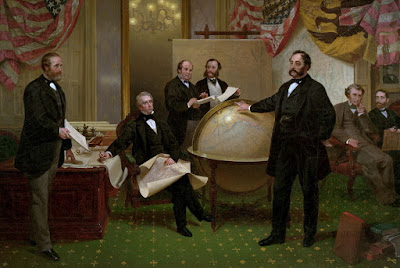March 30, 1867: Secretary of State William Seward buys Alaska from Russia
Throughout its history, Alaska had been home to numerous native tribes, most notably being the Aleut peoples. The Aleuts lived in relative seclusion until the arrival of Europeans in the 17th century. In the early 1700's, Russian surveyors mapped the Alaskan coast. It was not until 1741 that the Alaskan land mass was fully explored by an expedition led by Vitus Bering. The first permanent European settlement was established in 1784. In 1821, Tsar Alexander I officially declared Alaska as a Russian colony. The Monroe administration sought to mitigate Russia's influence in the Northwest. In 1824, Russia and the United States reached an agreement, which limited Russian expansion and opened up Alaskan ports to American shipping. Alaska would remain in Russian hands until 1867.
By the 1850's, Alaska had become a burden on Russia due to the cost of maintaining the colony. Since its devastating defeat in the Crimean War, the Russian treasury was nearly depleted. Alexander sought to sell the colony. Initially, he thought about selling it to Great Britain, who owned the adjacent territories of Canada, but by 1858, it was apparent that the United States would be more likely to buy. In the winter of 1859, Russian minister Eduard de Stoeckl began to negotiate with American diplomats. However, talks stalled due to the Civil War. The Russians decided to re-approached the British. When the Civil war ended in 1865, the American negotiations began anew. The negotiations commenced with the new Johnson administration under the purview of Secretary of State, William Seward. Seward was a very passionate advocate for the Alaskan purchase, wanting to
grow the United States' sphere of influence. Many congressional leaders, knowing that an eventual treaty would need their approval, thought the plan was a waste of money. Alaska was thought to be a icy wasteland. They nicknamed the plan as "Seward's Folly." The Secretary would not be dissuaded. On March 30, 1867, the American and Russian negotiators came to an agreement, which ceded Alaska to the United States for the sum total of 7.2 million dollars or 2 cents an acre.
"Seward's Folly" would prove to be exactly the opposite. At the end of the century, the territory would fill with settlers looking to reap the benefits for the nearby Klondike Gold Rush. The territory would achieve statehood in 1959., after which a different kind of gold would be discovered in the state. Oil would be discovered in the early 1960's forever changing the prospects of Alaska.
By the 1850's, Alaska had become a burden on Russia due to the cost of maintaining the colony. Since its devastating defeat in the Crimean War, the Russian treasury was nearly depleted. Alexander sought to sell the colony. Initially, he thought about selling it to Great Britain, who owned the adjacent territories of Canada, but by 1858, it was apparent that the United States would be more likely to buy. In the winter of 1859, Russian minister Eduard de Stoeckl began to negotiate with American diplomats. However, talks stalled due to the Civil War. The Russians decided to re-approached the British. When the Civil war ended in 1865, the American negotiations began anew. The negotiations commenced with the new Johnson administration under the purview of Secretary of State, William Seward. Seward was a very passionate advocate for the Alaskan purchase, wanting to
grow the United States' sphere of influence. Many congressional leaders, knowing that an eventual treaty would need their approval, thought the plan was a waste of money. Alaska was thought to be a icy wasteland. They nicknamed the plan as "Seward's Folly." The Secretary would not be dissuaded. On March 30, 1867, the American and Russian negotiators came to an agreement, which ceded Alaska to the United States for the sum total of 7.2 million dollars or 2 cents an acre.
"Seward's Folly" would prove to be exactly the opposite. At the end of the century, the territory would fill with settlers looking to reap the benefits for the nearby Klondike Gold Rush. The territory would achieve statehood in 1959., after which a different kind of gold would be discovered in the state. Oil would be discovered in the early 1960's forever changing the prospects of Alaska.





Comments
Post a Comment